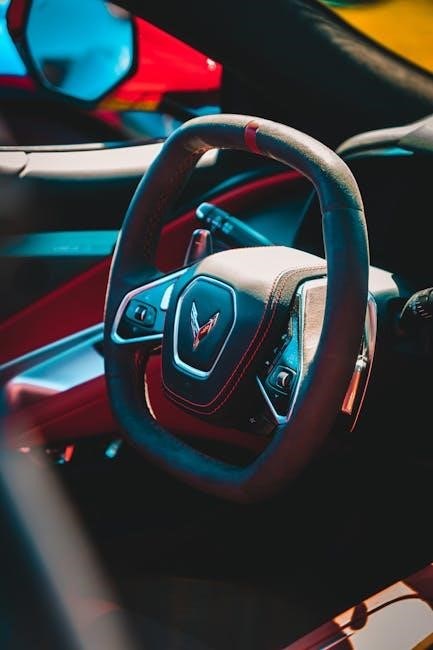Rokinon Auto Teleconverter 2x Manual: A Comprehensive Overview
The Rokinon 2x auto teleconverter, also known as a tele-extender, doubles the focal length of compatible lenses․ This manual teleconverter offers an affordable way to extend reach, particularly for wildlife or astrophotography․ Understanding its manual operation and compatibility is crucial for optimal use and image quality․
Teleconverters, also known as tele-extenders, are optical devices that fit between a camera body and a lens to increase the lens’s focal length․ They achieve this by magnifying the image before it reaches the camera sensor․ A 2x teleconverter, like the Rokinon model, doubles the effective focal length of the attached lens․ For example, a 300mm lens becomes a 600mm lens when used with a 2x teleconverter․

Teleconverters are popular among photographers who need extra reach without investing in longer, more expensive lenses․ They are frequently used in wildlife, sports, and astrophotography where subjects are often distant․ However, using a teleconverter also has certain trade-offs, such as a reduction in the amount of light reaching the sensor, which is typically measured in f-stops․
The Rokinon 2x teleconverter discussed here is a manual version, meaning it lacks electronic communication with the camera․ This impacts features like autofocus and aperture control, requiring the user to manually adjust these settings․ Understanding these limitations and benefits is key to successfully using a teleconverter․ The construction typically involves high-quality optical glass to minimize image degradation․
Understanding the 2x Magnification Factor
The “2x” in Rokinon 2x teleconverter signifies that it doubles the focal length of any compatible lens it’s attached to․ This means if you mount the teleconverter between your camera body and a 100mm lens, the resulting focal length will be 200mm․ Similarly, a 300mm lens will effectively become a 600mm lens․ This magnification factor allows photographers to achieve a tighter field of view, bringing distant subjects closer in the frame․
This magnification is beneficial in scenarios where physical proximity to the subject is limited, such as wildlife photography where approaching animals too closely could scare them away․ Astrophotography also benefits, allowing for tighter crops of celestial objects․
However, it’s crucial to remember that this magnification comes with trade-offs․ Primarily, the amount of light reaching the camera sensor is reduced․ A 2x teleconverter typically results in a loss of two f-stops․ Therefore, an f/2․8 lens becomes an f/5․6 lens when used with the 2x teleconverter․ This reduction in light can impact exposure settings and may necessitate longer shutter speeds or higher ISO values․ Understanding these implications is essential for achieving well-exposed images․

Focal Length Extension Explained
Focal length extension is the core function of a teleconverter․ In the case of the Rokinon 2x model, it doubles the existing focal length of the lens attached․ This extension effectively increases the lens’s reach, allowing you to capture images as if you were physically closer to the subject;
Imagine using a 135mm lens, often favored for portraits and astrophotography․ With the Rokinon 2x teleconverter, that 135mm lens transforms into a 270mm lens․ This increased reach is particularly valuable for situations where physical access is restricted or undesirable․
The extension is achieved through optical elements within the teleconverter that magnify the image projected by the primary lens․ While this magnification provides a significant advantage, it’s important to acknowledge that it doesn’t come without consequences․ The most notable effect is the reduction in light transmission, impacting the effective aperture․ Additionally, image quality can be affected, with potential increases in aberrations and softening of details, especially at wider apertures․ Therefore, understanding these trade-offs is essential for effectively utilizing the focal length extension offered by the Rokinon 2x teleconverter․
Light Loss and Aperture Impact
A significant consideration when using a teleconverter is the inherent light loss and its subsequent impact on the effective aperture․ The Rokinon 2x teleconverter, as its name suggests, doubles the focal length but also reduces the amount of light reaching the camera sensor․
Specifically, a 2x teleconverter results in a light loss equivalent to two f-stops․ For instance, if you attach the teleconverter to a lens with a maximum aperture of f/2․8, the resulting effective aperture becomes f/5․6․ This reduction in light has several implications for your photography․
Firstly, it necessitates longer exposure times to achieve proper exposure, potentially leading to motion blur if the subject or camera is not stable․ Secondly, it reduces the amount of light available for the autofocus system, potentially impacting its speed and accuracy․ Finally, the narrower aperture increases the depth of field, meaning more of the scene will be in focus, which may not always be desirable․
Understanding this light loss is crucial for adjusting camera settings and planning your shots accordingly․ You may need to increase ISO, use a tripod, or employ alternative focusing techniques to compensate for the aperture impact․
Manual Operation Considerations
The Rokinon 2x teleconverter is a manual teleconverter, meaning it lacks electronic communication with the camera body․ This absence of electronic communication leads to specific considerations for its operation․ Unlike modern lenses that automatically transmit aperture and focus information, the Rokinon teleconverter requires manual adjustments․
Firstly, the camera will not automatically recognize the lens or its effective aperture․ Photographers must manually set the aperture on the lens itself and meter accordingly, taking into account the two-stop light loss․ This requires a solid understanding of the exposure triangle and manual metering techniques․
Secondly, autofocus is not supported․ Focusing must be achieved manually, relying on the photographer’s skill and visual confirmation through the viewfinder or live view screen․ This can be challenging, especially when shooting moving subjects or in low-light conditions․
Furthermore, features like image stabilization may not function optimally, as the camera cannot accurately compensate for shake without lens data․ Therefore, utilizing a sturdy tripod and employing proper shooting techniques become even more crucial to minimize blur and ensure sharp images․ Embracing the manual nature of this teleconverter offers a unique, hands-on photographic experience․
Compatibility with Rokinon Lenses
The Rokinon 2x teleconverter is primarily designed for use with Rokinon lenses, particularly those featuring a T-mount adapter system․ However, compatibility extends beyond just the mount type․ Physical design and lens element placement play crucial roles in ensuring proper fit and optimal image quality․ Some Rokinon lenses may have rear elements that protrude too far, preventing the teleconverter from mounting correctly without potential damage․
Before attempting to attach the teleconverter, carefully inspect both the lens and teleconverter for any obstructions or potential points of contact․ Consult user manuals or online resources for specific compatibility charts or recommendations from other users who have paired the teleconverter with various Rokinon lenses․ It’s essential to verify that the lens is designed to accommodate teleconverters․
When using the teleconverter, be aware that it will magnify any existing lens aberrations or imperfections․ Pairing it with high-quality Rokinon lenses will generally yield better results than using it with lower-tier options․ Experimenting with different Rokinon lenses is recommended to determine the optimal combinations for achieving the desired image quality and focal length extension․
Third-Party Lens Compatibility
While the Rokinon 2x teleconverter is often marketed for use with Rokinon lenses, adventurous photographers may explore its compatibility with third-party lenses․ However, achieving successful results requires careful consideration and research․ Compatibility issues can arise due to variations in lens mount designs, rear element protrusions, and communication protocols between the lens and camera body․
Many third-party lenses, especially older manual focus lenses with adaptable mounts like T-mounts, can potentially be used with the Rokinon 2x teleconverter․ However, autofocus functionality will likely be lost, as the teleconverter is primarily designed for manual operation․ Additionally, image quality may suffer if the teleconverter is not properly matched to the optical characteristics of the third-party lens․
Before attempting to use the Rokinon 2x teleconverter with a third-party lens, it’s crucial to consult online forums, user reviews, and compatibility charts to identify known working combinations․ Look for reports from other photographers who have successfully paired the teleconverter with specific lens models․ Be prepared to experiment with different settings and potentially accept some degree of image degradation in exchange for the extended reach․
T-Mount Lens Compatibility
The Rokinon 2x teleconverter is notably compatible with T-mount lenses, offering a straightforward way to extend their focal length․ T-mount lenses, known for their adaptability, utilize a standard screw thread mount, allowing them to be easily attached to various camera systems using appropriate T-mount adapters․ This compatibility makes the Rokinon 2x teleconverter a versatile tool for photographers using these lenses․

The teleconverter simply fits between the T-mount lens and the T-mount adapter connected to the camera body․ This arrangement effectively doubles the focal length of the lens, providing increased magnification for distant subjects․ However, it’s important to remember that using a 2x teleconverter will result in a loss of two f-stops of light, requiring adjustments to exposure settings․
When using the Rokinon 2x teleconverter with T-mount lenses, ensure that all connections are secure and properly aligned to prevent image distortions or damage to the equipment․ Manual focusing will be necessary, as T-mount lenses typically lack autofocus capabilities․ Despite these considerations, the compatibility with T-mount lenses enhances the versatility of the Rokinon 2x teleconverter, especially in applications like astrophotography or wildlife photography where extended reach is essential․
Alternatives to Rokinon Teleconverters
While the Rokinon 2x manual teleconverter offers a cost-effective solution for extending focal length, several alternatives exist, each with its own set of advantages and disadvantages․ One option is teleconverters from other brands like Kenko, Tamron, and Sigma․ These brands often offer teleconverters designed for specific lens mounts, potentially providing better compatibility and image quality with those systems․
Another alternative is purchasing a longer focal length lens outright․ While more expensive, a dedicated long lens avoids the light loss and potential image degradation associated with teleconverters․ High-quality zoom lenses can also offer a versatile range of focal lengths without the need for additional accessories․
For photographers primarily using mirrorless systems, adapting lenses from other mounts can be an alternative․ This allows the use of vintage or specialized lenses, potentially paired with teleconverters designed for those mounts․ However, this approach often requires manual operation and may not support all camera features․ Ultimately, the best alternative depends on budget, desired image quality, and the specific photographic needs of the user․ Consider factors like autofocus capabilities, light gathering, and overall image sharpness when making a decision․
Applications in Photography: Wildlife and Astrophotography
The Rokinon 2x manual teleconverter finds practical applications in both wildlife and astrophotography, where extending focal length is often essential․ In wildlife photography, it allows photographers to capture distant subjects, such as birds or animals, without physically getting closer, minimizing disturbance and maximizing safety․ The 2x magnification effectively doubles the reach of existing lenses, bringing distant subjects into sharper focus․ However, users must be mindful of the light loss and potential for reduced autofocus performance, especially in challenging lighting conditions․ Manual focusing skills become crucial․
For astrophotography, the teleconverter enables capturing detailed images of celestial objects like the moon, planets, and nebulae․ By increasing the effective focal length, finer details become more visible․ The manual nature of the teleconverter is often less of a limitation in astrophotography, as focusing is typically done manually and precise tracking is required regardless․ Careful consideration should be given to the added weight and potential for vignetting, particularly with wider aperture lenses․ A sturdy tripod and stable mount are crucial for minimizing vibrations and ensuring sharp images during long exposures․
Used Market and Availability
The Rokinon 2x manual teleconverter is often found on the used market, offering a budget-friendly option for photographers seeking to extend their lens reach․ Availability can vary depending on the specific lens mount and overall demand․ Online marketplaces like eBay and specialized used camera equipment retailers are common places to find these teleconverters․ Prices typically reflect the condition of the teleconverter, ranging from well-worn to like-new․ When purchasing used, it’s essential to carefully inspect the optics for any signs of damage, such as scratches, fungus, or haze, which can negatively impact image quality․

Checking the functionality of the aperture control and ensuring smooth focusing is also crucial․ Consider the seller’s reputation and return policy before making a purchase․ While new Rokinon teleconverters might be available from authorized dealers, the used market provides access to older models or those that have been discontinued․ Exploring used options allows photographers to experiment with teleconverters without a significant financial investment․ However, be aware that warranty coverage may not be available for used items, so thorough inspection and testing are highly recommended․
The Rokinon 2x manual teleconverter presents a compelling option for photographers seeking to extend the reach of their existing lenses without a substantial investment․ Its manual operation requires a deliberate approach, demanding attention to focusing and exposure settings․ The 2x magnification factor provides a significant increase in focal length, beneficial for wildlife, astrophotography, or any situation requiring enhanced reach․
However, potential light loss and the need for manual adjustments should be carefully considered․ Compatibility with Rokinon and certain third-party lenses is a key factor in determining its suitability․ If you’re comfortable with manual focusing and exposure control, and if your lenses are compatible, the Rokinon 2x teleconverter can be a cost-effective tool to expand your photographic capabilities․ Conversely, if you prioritize autofocus and automatic exposure, or if your lenses aren’t compatible, exploring alternative teleconverters or longer lenses might be more appropriate․ Evaluate your specific needs and shooting style to make an informed decision․